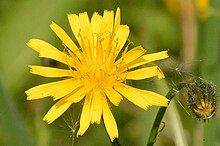Marsh Pippau
| Marsh Pippau | ||||||||||||
|---|---|---|---|---|---|---|---|---|---|---|---|---|

Marsh pippau ( Crepis paludosa ) |
||||||||||||
| Systematics | ||||||||||||
|
||||||||||||
| Scientific name | ||||||||||||
| Crepis paludosa | ||||||||||||
| ( L. ) Moench |
The Crepis paludosa ( Crepis paludosa ) is a plant from the genus Pippau ( Crepis ) within the family of Compositae (Asteraceae).
description
Vegetative characteristics
In contrast to the two-year-old Wiesen-Pippau , the Sumpf-Pippau is a deciduous, perennial herbaceous plant . It has a dark, strong root. The swamp Pippau reaches heights of growth of 30 to 80, exceptionally up to 120 centimeters. The tubular, mostly branched stem has sparsely protruding leaves.
The large, broadly egg-shaped, glabrous, bluish leaves on the underside are dentate; the upper leaves have a heart-shaped or spear-shaped and pointed auricle that surrounds the stem.
Generative characteristics
The flowering period is between May and August. The 8 to 12 millimeter long bracts are short, blackish hairy and glandular. The cup-shaped inflorescence contains only ray-flowers . The ray-florets are yellow. The stylus is blackish green.
The ( pappus ) is dirty-yellowish-white, brittle and fragile.
The number of chromosomes is 2n = 12.
ecology
The pollination is done by bees and flies. The diaspores spread through the wind.
Occurrence
The Swamp-Pippau belongs to the Nordic-Eurasian-sub-oceanic floral elements . It occurs in Central, Eastern and Northern Europe and the British Isles, as well as in Turkey and western Siberia. In Germany it is widespread and only rare in warm and dry regions. In the Alps, it thrives at altitudes of 1920 meters. In the Allgäu Alps, it rises in Vorarlberg between Unterkrumbach and Haldenwanger Eck to an altitude of 1780 meters.
The Crepis paludosa is a half light plant of wet meadows and moors , the breaking and riparian forests and the Hochstaudenfluren and bushes. It thrives on wet, nutrient-rich and humus-rich clay soils . It is a Calthion association character in Central Europe.
literature
- Erich Oberdorfer : Plant-sociological excursion flora . With the collaboration of Theo Müller. 5th, revised and expanded edition. Eugen Ulmer, Stuttgart (Hohenheim) 1983, ISBN 3-8001-3429-2 .
- Marsh Pippau. In: FloraWeb.de.
Individual evidence
- ↑ a b Erich Oberdorfer : Plant-sociological excursion flora for Germany and neighboring areas. 8th edition. Stuttgart, Verlag Eugen Ulmer, 2001. Pages 994-995. ISBN 3-8001-3131-5
- ↑ Crepis paludosa in the Germplasm Resources Information Network (GRIN), USDA , ARS , National Genetic Resources Program. National Germplasm Resources Laboratory, Beltsville, Maryland. Retrieved April 8, 2018.
- ↑ Erhard Dörr, Wolfgang Lippert : Flora of the Allgäu and its surroundings. Volume 2, IHW, Eching 2004, ISBN 3-930167-61-1 , p. 682.
Web links
- Crepis paludosa (L.) Moench, Swamp-Pippau. In: FloraWeb.de.
- Marsh Pippau . In: BiolFlor, the database of biological-ecological characteristics of the flora of Germany.
- Profile and distribution map for Bavaria . In: Botanical Information Hub of Bavaria .
- Crepis paludosa (L.) Moench In: Info Flora , the national data and information center for Swiss flora . Retrieved July 8, 2016.
- Map of the entire area
- Thomas Meyer: Pippau data sheet with identification key and photos at Flora-de: Flora von Deutschland (old name of the website: Flowers in Swabia ).


